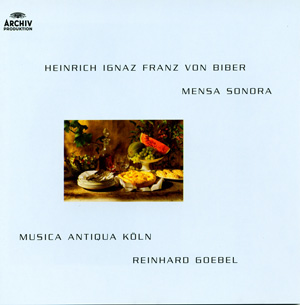|
|
|
01 |
Mensa sonora I in D major - Sonata. Grave - Allegro |
|
|
|
01:12 |
|
|
02 |
Mensa sonora I in D major - Allamanda |
|
|
|
02:27 |
|
|
03 |
Mensa sonora I in D major - Courante |
|
|
|
01:10 |
|
|
04 |
Mensa sonora I in D major - Sarabanda |
|
|
|
01:27 |
|
|
05 |
Mensa sonora I in D major - Gavotte |
|
|
|
01:14 |
|
|
06 |
Mensa sonora I in D major - Gigue - Sonatina. Adagio |
|
|
|
02:08 |
|
|
07 |
Mensa sonora II in F major - Intrada. Alla breve |
|
|
|
00:26 |
|
|
08 |
Mensa sonora II in F major - Balletto. Alla breve |
|
|
|
02:09 |
|
|
09 |
Mensa sonora II in F major - Sarabanda |
|
|
|
01:54 |
|
|
10 |
Mensa sonora II in F major - Balletto. Alla breve |
|
|
|
00:43 |
|
|
11 |
Mensa sonora II in F major - Sarabanda |
|
|
|
01:20 |
|
|
12 |
Mensa sonora II in F major - Balletto. Alla breve |
|
|
|
00:41 |
|
|
13 |
Mensa sonora III in A minor - Gagliarda. Allegro |
|
|
|
01:25 |
|
|
14 |
III in A minor - Sarabanda |
|
|
|
02:20 |
|
|
15 |
Mensa sonora III in A minor - Aria |
|
|
|
00:45 |
|
|
16 |
Mensa sonora III in A minor - Ciacona |
|
|
|
04:22 |
|
|
17 |
Mensa sonora III in A minor - Sonatina. (Adagio - Presto) |
|
|
|
00:47 |
|
|
18 |
Sonata representativa, A major, Allegro |
|
|
|
02:10 |
|
|
19 |
Sonata representativa, A major, Die Nactigall |
|
|
|
01:32 |
|
|
20 |
Sonata representativa, A major, Cucu |
|
|
|
00:38 |
|
|
21 |
Sonata representativa, A major, Der Frosch |
|
|
|
01:13 |
|
|
22 |
Sonata representativa, A major, Allegro: Die Henne, Der Hahn |
|
|
|
00:37 |
|
|
23 |
Sonata representativa, A major, Allegro: Die Henne, Der Hahn |
|
|
|
00:47 |
|
|
24 |
Sonata representativa, A major, Die Katz |
|
|
|
00:35 |
|
|
25 |
Sonata representativa, A major, Musketier-Marsch |
|
|
|
00:40 |
|
|
26 |
Sonata representativa, A major, (Allemande) |
|
|
|
02:20 |
|
|
27 |
Mensa sonora IV in B flat major - Sonata. (Grave - Allegro - Adagio) |
|
|
|
01:21 |
|
|
28 |
Mensa sonora IV in B flat major - Allamanda |
|
|
|
01:55 |
|
|
29 |
Mensa sonora IV in B flat major - Courante |
|
|
|
01:03 |
|
|
30 |
Mensa sonora IV in B flat major - Balletto |
|
|
|
00:31 |
|
|
31 |
Mensa sonora IV in B flat major - Sarabanda |
|
|
|
02:20 |
|
|
32 |
Mensa sonora IV in B flat major - Gigue. Presto |
|
|
|
01:19 |
|
|
33 |
Mensa sonora IV in B flat major - Sonatina. Adagio |
|
|
|
01:03 |
|
|
34 |
Mensa sonora V in E major - Intrada. Allegro |
|
|
|
01:09 |
|
|
35 |
Mensa sonora V in E major - Balletto |
|
|
|
00:33 |
|
|
36 |
Mensa sonora V in E major - Trezza |
|
|
|
00:54 |
|
|
37 |
Mensa sonora V in E major - Gigue |
|
|
|
00:52 |
|
|
38 |
Mensa sonora V in E major - Gavotte. Alla breve |
|
|
|
00:58 |
|
|
39 |
Mensa sonora V in E major - Gigue |
|
|
|
00:56 |
|
|
40 |
Mensa sonora V in E major - Retirada |
|
|
|
00:41 |
|
|
41 |
Mensa sonora VI in G minor - Soanta. (Adagio - Presto) |
|
|
|
00:38 |
|
|
42 |
Mensa sonora VI in G minor - Aria |
|
|
|
01:22 |
|
|
43 |
Mensa sonora VI in G minor - Canario. Presto |
|
|
|
00:42 |
|
|
44 |
Mensa sonora VI in G minor - Amener |
|
|
|
00:41 |
|
|
45 |
Mensa sonora VI in G minor - Trezza |
|
|
|
00:51 |
|
|
46 |
Mensa sonora VI in G minor - Ciacona |
|
|
|
04:04 |
|
|
47 |
Mensa sonora VI in G minor - Sonatina. Adagio - Presto |
|
|
|
00:31 |
|
